Showing Spotlights 905 - 912 of 2784 in category All (newest first):
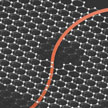 Traditionally, the size of electrode materials in supercapacitors is reduced to nanometers to enable high surface area and more room for storing more amounts of energy. But the microscopic electron distribution in nanocarbons limits the total amount of stored energy through a property called 'quantum capacitance'.
Although a lot of charge could be stored in the pores on nanocarbons due to their high surface area, their inherently low quantum capacitance reduces the net energy that could be drawn from supercapacitors. Researchers have controllably added nitrogen atoms to graphene to achieve carbon supercapacitors ready for practical applications.
Traditionally, the size of electrode materials in supercapacitors is reduced to nanometers to enable high surface area and more room for storing more amounts of energy. But the microscopic electron distribution in nanocarbons limits the total amount of stored energy through a property called 'quantum capacitance'.
Although a lot of charge could be stored in the pores on nanocarbons due to their high surface area, their inherently low quantum capacitance reduces the net energy that could be drawn from supercapacitors. Researchers have controllably added nitrogen atoms to graphene to achieve carbon supercapacitors ready for practical applications.
Aug 25th, 2016
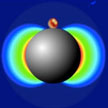 Localization of photons to nanoscale volumes with the aid of plasmonic nanoantennas opened new horizons in bio(chemical) sensing and nanoscale imaging. However, plasmon resonances are short-lived, and the photon energy quickly dissipates as heat, creating temperature gradients on plasmonic chips. In new work, researchers have proposed design rules to engineer hybrid optical-thermal antennas that offer multiple functionalities in nanoscale light and heat management.
Localization of photons to nanoscale volumes with the aid of plasmonic nanoantennas opened new horizons in bio(chemical) sensing and nanoscale imaging. However, plasmon resonances are short-lived, and the photon energy quickly dissipates as heat, creating temperature gradients on plasmonic chips. In new work, researchers have proposed design rules to engineer hybrid optical-thermal antennas that offer multiple functionalities in nanoscale light and heat management.
Aug 24th, 2016
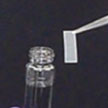 The fact that temperature differentials (heat) are ubiquitously present in our environment makes thermoelectric energy harvesting a highly attractive research field. New work highlights the fabrication of flexible thermoelectric materials and modules by merging colloidal nanomaterials (quantum dots) that can be tuned for efficient heat-to-electricity energy conversion with naturally abundant cellulose paper that are low in cost and have inherently low thermal conductivity.
The fact that temperature differentials (heat) are ubiquitously present in our environment makes thermoelectric energy harvesting a highly attractive research field. New work highlights the fabrication of flexible thermoelectric materials and modules by merging colloidal nanomaterials (quantum dots) that can be tuned for efficient heat-to-electricity energy conversion with naturally abundant cellulose paper that are low in cost and have inherently low thermal conductivity.
Aug 23rd, 2016
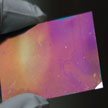 Point-of-care diagnostics, food safety screening, and environmental monitoring will massively benefit from the label-free, inexpensive, rapid, handheld sensor devices that are currently under development. To date, there has been a lot of work reported on either SERS or plasmonic sensing but very few have reported sensing with the same device for both SERS and plasmonics, let alone plasmonic colorimetry naked-eye sensing. For the first time ever, researchers have reported the combination of naked-eye plasmonic colorimetry and high-enhancement and high-uniformity SERS in one sensor.
Point-of-care diagnostics, food safety screening, and environmental monitoring will massively benefit from the label-free, inexpensive, rapid, handheld sensor devices that are currently under development. To date, there has been a lot of work reported on either SERS or plasmonic sensing but very few have reported sensing with the same device for both SERS and plasmonics, let alone plasmonic colorimetry naked-eye sensing. For the first time ever, researchers have reported the combination of naked-eye plasmonic colorimetry and high-enhancement and high-uniformity SERS in one sensor.
Aug 19th, 2016
 Sodium-ion batteries (SIBs) represent an attractive alternative to lithium-ion batteries, owing to the fact that sodium resources are practically inexhaustible and evenly distributed around the world while the ion insertion chemistry is largely identical to that of lithium. Researchers have now rationally designed and fabricated a sodium ion full battery where both of the cathode and anode materials possessed very unique two-dimensional nanostructured architecture. The 2D nanostructured architecture results in excellent rate capability and stable cycling performance.
Sodium-ion batteries (SIBs) represent an attractive alternative to lithium-ion batteries, owing to the fact that sodium resources are practically inexhaustible and evenly distributed around the world while the ion insertion chemistry is largely identical to that of lithium. Researchers have now rationally designed and fabricated a sodium ion full battery where both of the cathode and anode materials possessed very unique two-dimensional nanostructured architecture. The 2D nanostructured architecture results in excellent rate capability and stable cycling performance.
Aug 17th, 2016
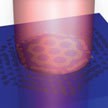 Graphene, one of the most exciting two-dimensional materials, has shown extraordinary optical properties due to strong surface plasmon polaritons supported by graphene nanostructure. Graphene metasurfaces show plasmonic resonance bands that can be tuned from mid-infrared to terahertz regime. These plasmonic devices can be used for biosensing, spectroscopy, light modulation and communication applications. Researchers now demonstrate for the first time an effective method to pattern large area graphene into moire metasurfaces with gradient nanostructures having multiband resonance peaks in mid infrared range.
Graphene, one of the most exciting two-dimensional materials, has shown extraordinary optical properties due to strong surface plasmon polaritons supported by graphene nanostructure. Graphene metasurfaces show plasmonic resonance bands that can be tuned from mid-infrared to terahertz regime. These plasmonic devices can be used for biosensing, spectroscopy, light modulation and communication applications. Researchers now demonstrate for the first time an effective method to pattern large area graphene into moire metasurfaces with gradient nanostructures having multiband resonance peaks in mid infrared range.
Aug 16th, 2016
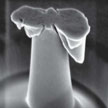 Whether it is possible to achieve high formability in quasicrystals and how quasicrystals are plastically deformed at room temperature have been long-standing questions since their discovery. In new work, an international group of researchers has found that a typically brittle quasicrystal exhibits superior ductility (ductility is a solid material's ability to deform under stress without fracture) at the sub-micrometer scales and at room temperature. Furthermore, their experiments indicate that 'dislocation glide' could be the dominating deformation mechanism for quasicrystals under high-stress and low temperature conditions, which has been not poorly understood before.
Whether it is possible to achieve high formability in quasicrystals and how quasicrystals are plastically deformed at room temperature have been long-standing questions since their discovery. In new work, an international group of researchers has found that a typically brittle quasicrystal exhibits superior ductility (ductility is a solid material's ability to deform under stress without fracture) at the sub-micrometer scales and at room temperature. Furthermore, their experiments indicate that 'dislocation glide' could be the dominating deformation mechanism for quasicrystals under high-stress and low temperature conditions, which has been not poorly understood before.
Aug 12th, 2016
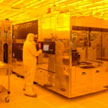 The entry of nanotechnology into manufacturing has been compared to the advent of earlier technologies that have profoundly affected modern societies, such as plastics, semiconductors, and even electricity. Applications of nanotechnology promise transformative improvements in materials performance and longevity for electronics, medicine, energy, construction, machine tools, agriculture, transportation, clothing, and other areas. However, the path to greater benefits from nanomanufactured goods and services is not yet clear. This review takes silicon integrated circuit manufacturing as a baseline in order to consider the factors involved in matching processes with products, examining the characteristics and potential of top-down and bottom-up processes, and their combination.
The entry of nanotechnology into manufacturing has been compared to the advent of earlier technologies that have profoundly affected modern societies, such as plastics, semiconductors, and even electricity. Applications of nanotechnology promise transformative improvements in materials performance and longevity for electronics, medicine, energy, construction, machine tools, agriculture, transportation, clothing, and other areas. However, the path to greater benefits from nanomanufactured goods and services is not yet clear. This review takes silicon integrated circuit manufacturing as a baseline in order to consider the factors involved in matching processes with products, examining the characteristics and potential of top-down and bottom-up processes, and their combination.
Aug 11th, 2016
 Traditionally, the size of electrode materials in supercapacitors is reduced to nanometers to enable high surface area and more room for storing more amounts of energy. But the microscopic electron distribution in nanocarbons limits the total amount of stored energy through a property called 'quantum capacitance'.
Although a lot of charge could be stored in the pores on nanocarbons due to their high surface area, their inherently low quantum capacitance reduces the net energy that could be drawn from supercapacitors. Researchers have controllably added nitrogen atoms to graphene to achieve carbon supercapacitors ready for practical applications.
Traditionally, the size of electrode materials in supercapacitors is reduced to nanometers to enable high surface area and more room for storing more amounts of energy. But the microscopic electron distribution in nanocarbons limits the total amount of stored energy through a property called 'quantum capacitance'.
Although a lot of charge could be stored in the pores on nanocarbons due to their high surface area, their inherently low quantum capacitance reduces the net energy that could be drawn from supercapacitors. Researchers have controllably added nitrogen atoms to graphene to achieve carbon supercapacitors ready for practical applications.
 Subscribe to our Nanotechnology Spotlight feed
Subscribe to our Nanotechnology Spotlight feed





